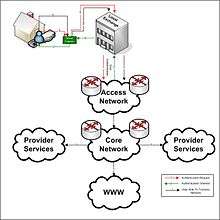Access network
An access network is a type of telecommunications network which connects subscribers to their immediate service provider. It is contrasted with the core network, (for example the Network Switching Subsystem in GSM) which connects local providers to each other. The access network may be further divided between feeder plant or distribution network, and drop plant or edge network.
Telephone heritage
An access network or outside plant refers to the series of wires, cables and equipment lying between a consumer/business telephone termination point (the point at which a telephone connection reaches the customer) and the local telephone exchange. The local exchange contains banks of automated switching equipment to direct a call or connection to the consumer. The access network is perhaps one of the oldest assets a telecoms operator owns, and is constantly evolving, growing as new customers are connected, and as new services are offered. This makes the access network one of the most complex networks in the world to maintain and keep track of.
In 2007–2008 many telecommunication operators experienced increasing problems maintaining the quality of the records which describe the network. In 2006, according to an independent Yankee Group report, globally operators experience profit leakage in excess of €15 Billion each year.
The access network is also perhaps the most valuable asset an operator owns, since this is what physically allows them to offer a service.
Access networks consist largely of pairs of copper wires, each traveling in a direct path between the exchange and the customer. In some instances, these wires may even be aluminum, the use of which was common in the 1960s and 1970s following a massive increase in the cost of copper. As it happened, the price increase was temporary, but the effect of this decision is still felt today because the aluminum wires oxidize and lose their ability to carry large quantities of data.
Access is essential to the future profitability of operators who are experiencing massive reductions in revenue from plain old telephone services, due in part to the opening of historically nationalized companies to competition, and in part to increased use of mobile phones and voice over IP (VoIP) services. Operators offered additional services such as xDSL based broadband and IPTV (Internet Protocol Television) to guarantee profit. The access network is again the main barrier to achieving these profits since operators worldwide have accurate records of only 40% to 60% of the network. Without understanding or even knowing the characteristics of these enormous copper spider webs, it is very difficult, and expensive to 'provision' (connect) new customers and assure the data rates required to receive next generation services.
Access networks around the world evolved to include more and more optical fiber technology. Optical fibre already makes up the majority of core networks and will start to creep closer and closer to the customer, until a full transition is achieved, delivering value added services over fiber to the home (FTTH).
Access process

The process of communicating with a network begins with an access attempt, in which one or more users interact with a communications system to enable initiation of user information transfer. An access attempt itself begins with an issuance of an access request by an access originator.
An access attempt ends either in successful access or in access failure - an unsuccessful access that results in termination of the attempt in any manner other than initiation of user information transfer between the intended source and destination (sink) within the specified maximum access time.
Access failure can be the result of access outage, user blocking, incorrect access, or access denial. Access denial (system blocking) can include:
- Access failure caused by the issuing of a system blocking signal by a communications system that does not have a call-originator camp-on feature.
- Access failure caused by exceeding the maximum access time and nominal system access time fraction during an access attempt.
Charging for access
An access charge is a charge made by a local exchange carrier for use of its local exchange facilities for a purpose such as the origination or termination of network traffic that is carried to or from a distant exchange by an interexchange carrier.
Although some access charges are billed directly to interexchange carriers, a significant percentage of all access charges are paid by the local end users.
Mobile access networks
Optical distribution network
A passive optical distribution network (PON) uses single mode optical fibre in the outside plant, optical splitters and optical distribution frames, duplexed so that both upstream and downstream signals share the same fibre on separate wavelengths. Faster PON standards generally support a higher split ratio of users per PON, but may also use reach extenders/amplifiers where extra coverage is needed. Optical splitters creating a point to multipoint topology are also the same technology regardless of the type of PON system, making any PON network upgradable by changing the ONT and OLT terminals at each end, with minimal change to the physical network.
Access networks usually also must support point-to-point technologies such as Ethernet, which bypasses any outside plant splitter to achieve a dedicated link to the Central Office. Some PON networks use a "home run" topology where roadside cabinets only contain patch panels so that all splitters are located centrally. While a 20% higher capital cost could be expected, home run networks may encourage a more competitive wholesale market since providers' equipment can achieve higher utilisation.[1]
See also
References
External links
- "The Network Story". British Telecom. 2005. Archived from the original on 5 May 2010. Interactive presentation introducing the technology and design of access networks